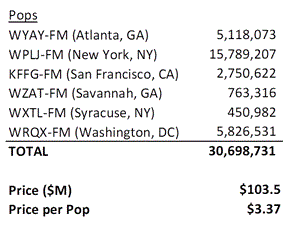Less than 24 hours after one of the biggest radio station transactions in recent memory was consummated, media brokers and industry observers appear to be split in their reaction to the purchase price struck for six highly regarded FMs being sold by Cumulus Media to Educational Media Foundation.
One highly regarded broker praised Cumulus for getting a deal done. At the same time, an observer who requested anonymity is simply dumbstruck by the low valuation given to the facilities going to EMF.
That reaction may pale to the one many may have to this just-uncovered fact: Cumulus and EMF have been working for weeks on a deal that was finalized on the final day of January.
For a total purchase price of $103.5 million, EMF is getting the following stations from Cumulus:
- Hot AC WPLJ-FM 95.5 in New York, a Class B facility with a rich Rock heritage that in July 1983 morphed to CHR/Pop, and in the early 1990s to its current format.
- News/Talk WYAY-FM 106.7 in Gainesville, Ga., a Class C facility east of Atlanta known as “Y106” and for its Country format from 1984-2000.
- Hot AC WRQX-FM 107.3, a Class B giant in Washington, D.C., with a near city-grade signal over much of Baltimore County, Md. known as “Mix 107.3” since fall 1990. Before that, it was CHR as “Q107” for all of the 1980s, competing against WAVA-FM 105.1. Interestingly, WAVA flipped from CHR to Christian Talk and Worship Music on Feb. 14, 1992, following its sale from Emmis Communications to Salem Media Group.
- Class A KFFG-FM 97.7 in Los Altos, Calif., acquired to bring KFOG-FM 104.5’s signal to Silicon Valley and San Jose. The simulcast dates to August 7, 1995, when the station was sold to Susquehanna Radio.
- Class C0 WZAT-FM 102.1 in Savannah, Ga. This facility, licensed to Tybee Island, placed last among all FMs in the most recent Nielsen Audio ratings for the market. WZAT had been a highly successful Top 40 station as “Z102” during the 1980s.
- Class A Rocker WXTL-FM 105.9 in Syracuse, a Class A with a north-facing signal. It airs the Premiere Networks-syndicated Bob & Tom in morning drive.
According to a Form 314 filing with the FCC made Feb. 14, Cumulus had been working on a deal with EMF for months. An Escrow Agreement linked to KFFG agreed upon by EMF and Cumulus is dated Dec. 31, 2018.
At the time, a $20 million payment was made by EMF to Cumulus and is being held for Cumulus by BB&T, the large North Carolina bank merging with SunTrust. This reflects a 10% deposit plus “additional funds.”
Furthermore, a letter of intent was inked between EMF and Cumulus on October 4, 2018, FCC documents show.
The asset purchase agreement signed by Cumulus EVP and General Counsel Richard Denning and EMF VP/Radio Randy Chase is dated Jan. 31, 2019.
This suggests that Cumulus waited for Entercom’s final OK for a station swap that was first put in motion more than four months ago.
Additionally, RBR+TVBR has learned that Cumulus’ exclusive broker in this transaction is Scott Knoblauch. Knoblauch has worked closely with Cumulus on station divestitures for several years. In May 2013, Knoblauch resigned as the custodian of 10 stations forced into trusteeship by the various machinations of Cumulus’ merger with Citadel, handing the properties to Media Services Group broker Eddie Esserman.
‘SMART’ SALE FOR POST-BANKRUPTCY PLAYER
With Thursday’s Opening Bell on Wall Street, Cumulus shares recouped some of the lost value seen since their reemergence in August 2018 on Nasdaq; like iHeartMedia, Cumulus traded with the “Q” designation, noting debtor-in-possession status, while under Chapter 11 bankruptcy protection.
As of 1:33pm Eastern, CMLS was trading at $15.20, up 3.1% from Wednesday’s close. That puts Cumulus shares at their highest point since the week of October 22, 2018.
Post-bankruptcy, Cumulus shares peaked at $20.90 in late August 2018.
Investors may be encouraged by Cumulus’ debt-slashing deal with EMF, in addition to lowering expenses by trading WNSH-FM 94.7 in New York and two Massachusetts properties to Entercom in exchange of three FMs serving Indianapolis.
For Elliot Evers, the deal is a winner. “This is a really smart deal for Cumulus,” the Managing Director of San Francisco-based MVP Capital tells RBR+TVBR. “It is highly accretive. The multiple is probably higher than 16x, but EMF doesn’t care about broadcast cash flow or multiples. They are just looking for distribution, and they got a big chunk of that from this deal.”
Evers’ team at MVP Capital worked out the math as of Noon Pacific on Thursday. EMF will be paying slightly more than $3 per “pop” for the Cumulus stations.

The KFFG population statistics reflect the San Francisco-Oakland-San Jose DMA.
“This is their norm,” he said. “The deals work well for them at that level. It is consistent with almost every major-market FM deal EMF has done over the past five years or more.”
For Boca Raton, Fla.-based broker Michael Bergner, attention has been placed on tower income, and if EMF will benefit from this.
Yes. EMF is acquiring all of the transmission equipment and assuming all of tower leases associated with the Cumulus stations, which collectively contribute approximately $5 million to $7 million of EBITDA to Cumulus annually. Consider this added dollars to EMF’s rich tax-free coffers.
READY PLAYER ONE
While Evers calls the Cumulus/EMF deal a smart one, others are expressing shock that the transaction was consummated at such a low price.
One industry observer who requested anonymity tells RBR+TVBR, “I don’t think I’ve ever seen such a low valuation of major-market radio stations, forgetting Savannah, Ga., and Syracuse. You have three of the crown jewels of ABC Radio.”
K-LOVE is also getting a Central New York FM with full coverage of its home market, a foothold in the heart of digital technologies, and a 98,000-watt blowtorch of a signal that can easily be heard in Hilton Head Island, Beaufort, and communities near Charleston, S.C., as well as the northern fringe of the Jacksonville, Fla., area.
But, as Bergner wonders, was EMF really the only buyer? And, given what he views as the underperformance of the stations Cumulus is selling, a leverage reduction had to be done — even if the valuation was a historic low.
The industry observer who spoke with RBR+TVBR recalled how different the marketplace is today compared to August 1995. The August 4, 1995 edition of now-defunct trade publication Radio and Records read: Radio’s ‘Amazing’ $3 Billion Week!
Westinghouse had purchased CBS Radio for $5.4 billion; The Walt Disney Company acquired ABC Radio as part of its Capital Cities acquisition, valued at $19 billion. The sale of WABC-AM and WPLJ-FM in New York had an accretive value of $130 million.
Nearly 24 years later, EMF — for $26.5 million less — is getting WRQX, WYAY, WZAT, KFFG and a Class A in Syracuse.
This raises another question: What will Cumulus do with, as the industry observer refers to them, “those naked AMs in New York and Washington?”
Truth be told, Cumulus’ WABC-AM 770 in New York — America’s No. 1 Top 40 station from the 1960s through the end of the 1970s — is still paired with an FM, Class A WNBM-FM 103.9 in Bronxville, N.Y., an Urban Contemporary station with a signal situated over the Bronx and Queens — the heart of New York’s African-American community.
Is WNBM, once AC WFAS-FM serving Westchester County, in play, too?
Then, there is Washington, D.C., where News/Talk WMAL-AM 630 simulcasts on 105.9 MHz, once a Classic Rocker with the call letters WCXR. Could Cumulus keep the intellectual property of WRQX and move it to WMAL-FM, a Class B facility licensed to Woodbridge, Va., with a tower where Lee Highway crosses the Capital Beltway? While WMAL-FM is short-spaced to WJZ-FM 105.7 in Baltimore, it could save Hot AC programming in the D.C. area.
It’s a hot rumor, and it involves Hubbard Broadcasting. Rather than Cumulus keep WMAL-AM & FM, attendees of the Country Radio Seminar in Nashville tell RBR+TVBR a spin to Hubbard makes perfect sense: WRQX at 105.9 MHz gives the company a Hot AC that’s in a rebound while, more importantly, it “locks up” commercial spoken word programming in a battle against American University’s NPR Member station WAMU-FM.
Or, Cumulus could keep the AMs. The industry observer believes this is likely because stations such as WMAL and WABC clear syndicated radio programming from Cumulus’ Westwood One national unit. Without those stations in the mix, there’s no guarantee WWO programming could reach these top markets.
What’s certain is that FMs were sold by Cumulus, and at a low price.
The industry observer asks, “So, EMF is the highest buyer of facilities and now we see it here. And, if people say there is a terribly low price for the highest buyer, then who was the backup buyer? I don’t think there was one. They have the money [at EMF] and it is real.”
WHERE THE CASH REGISTER RINGS
According to Duncan’s American Radio, Westinghouse’s 1996 acquisition of Infinity Broadcasting created some eye-popping valuations for New York radio stations. WFAN-AM 660 was sold for $264 million. WXRK-FM, the original home for Howard Stern’s morning show, was dealt at a value placed at $286 million.
Even 30 years ago, valuations in Gotham were higher than today. The sale of WNEW-FM 102.7 from Metropolitan Broadcasting to Sillerman Acquisition Corp. was priced at $80 million.
For the industry observer, “It’s a story of where we are in the radio business today. They took NASH FM and Springfield they swapped it for Indianapolis. It may be that being in a market like Indianapolis may be a better business proposition for radio than being in New York.”
The observer points to technology — audio streaming via Pandora and Spotify, podcasts, Sirius XM Satellite Radio — as being “less erosive” to radio stations in middle and small-sized markets. “When you talk to operators in these markets, you hear that business is not so bad,” the observer notes. “In Atlanta, and Washington, and in New York, business is off by more than 1%. In markets where there is no TV involvement, radio stations are making cash registers ringing.”
Therefore, Cumulus’ commitment to markets such as Indianapolis paints a new portrait of an industry in flux — with a future perhaps focused away from the nation’s biggest population centers.





